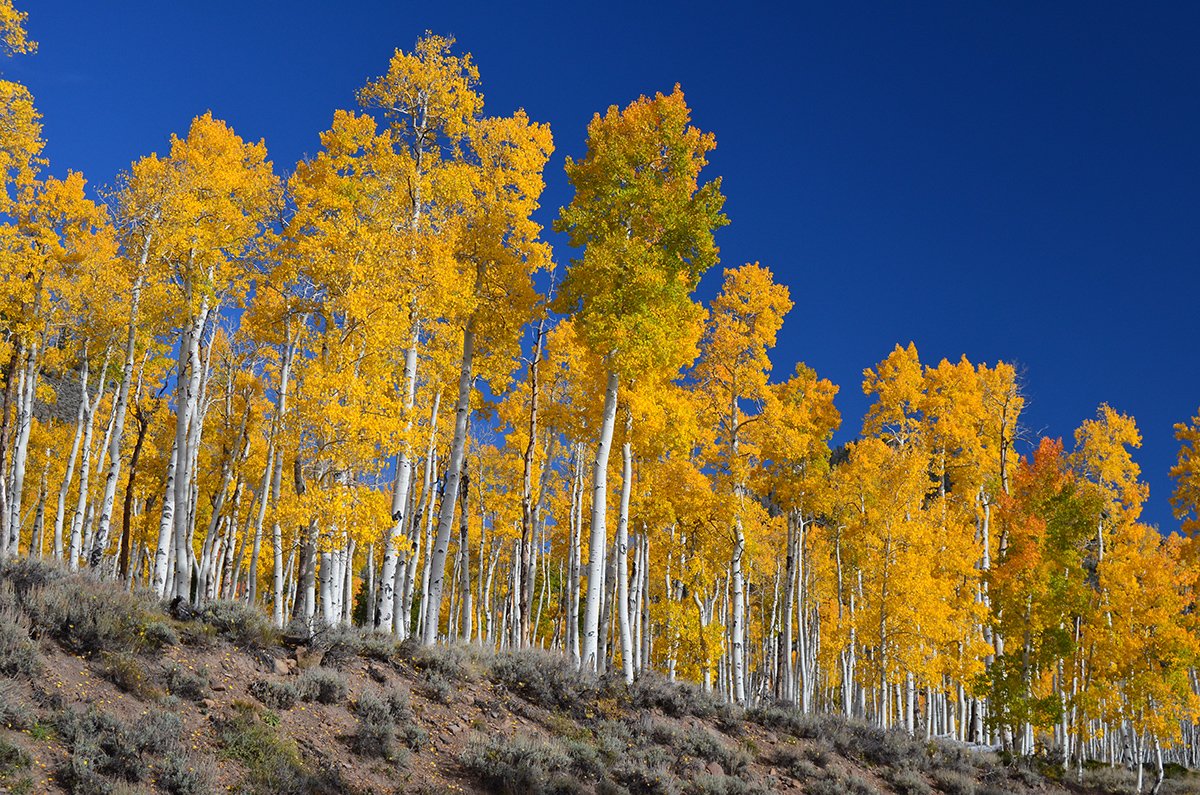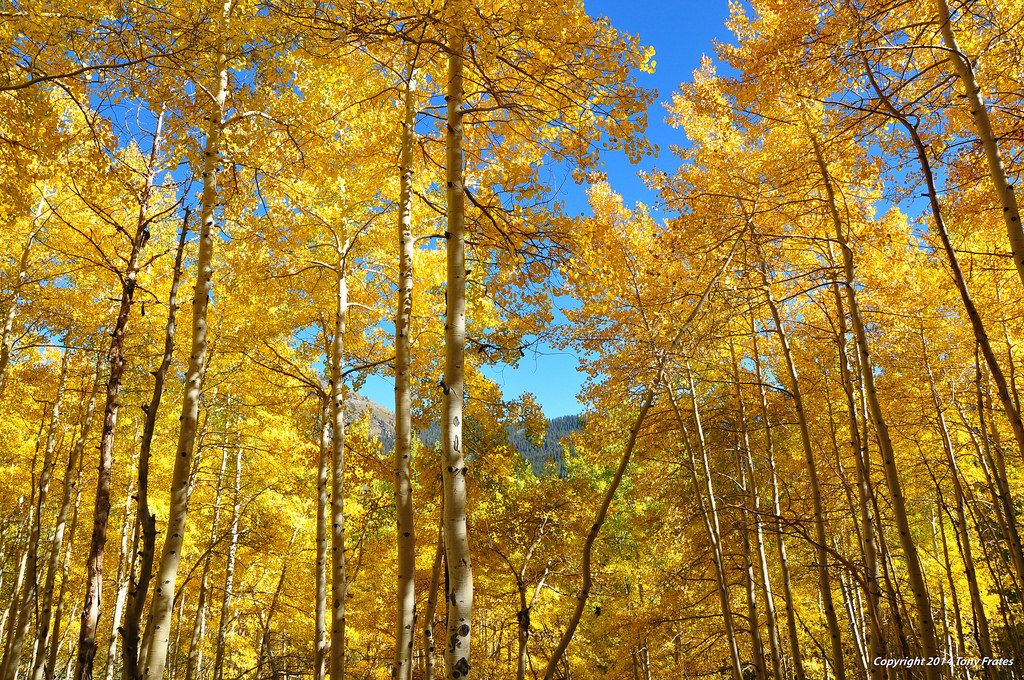Welcome back nature-lovers! Since summer is over and autumn leaves are soon to come, I thought of taking you on a relaxing stroll in the woods of Utah today! We are visiting The Fish Lake National Forest. About 1 mile southwest of the lake we will find an amazing forest of quaking aspens (populus tremuloides) spreading over an area of more than 100 acres.
(Image source: wikimedia.org)
That's all folks! This was today's strange phenomenon. A huge forest with whitish trunks and yellow leaves!
Meeeh! You didn't buy that, did you? The weird and remarkable fact about this particular forest is that you're not facing groups of trees but a gigantic web of clones popping out of ONE SINGLE organism!
You mean like ONE tree?
Exactly! The "Trembling Giant" is basically one of the largest and one of the oldest living organisms on earth! Thanks to Burton V. Barnes (expert in aspen trees and colonies - University of Michigan) in 1968 Pando came to the scientists' attention. Barnes claimed that the colony originated from one seedling that grew its clones over the area. In 1992 (when technology was advanced enough) Michael Grant (University of Colorado) confirmed that the colony was actually one single-organism system.
Pando comes from a latin verb meaning "spread" and didn't get its name out of luck or because it just sounded nice (to me Pando sounds more like a dog name). This amazing organism is a male quaking aspen that used cloning to survive and reproduce (When you are not that good with women it's a good idea to be able to clone yourself for eternity I guess).
Being born estimatedly 80,000 years ago (some argue it would be even as old as 1 million years, but studies on a molecular level consider this a non-plausible theory). Pando numbers almost 47,000 stems! The tree-trees, how we should call it is a bit obscure, weigh almost 6,000 tons (it's surely the heaviest living organism on the planet) and spread over 43 hectares.
 (Image source: wikimedia.org)
(Image source: wikimedia.org)
How did a male give birth to a whole forest?
Well, trees, like all plants, reproduce heterosexually through the combination of a male and a female or when a tree bears both sexes' reproductive organs. Pando, although it can reproduce through male and female flowers (seedling), uses another method and reproduces vegetatively. This means that it spreads its roots horizontally underground and on those roots the new stems will grow vertically to get out of the ground and become the new clones. The clones will then grow into trunks of normal trees (with branches and leaves) and may reach 100 feet (30 meters) in height. It is possible for a single aspen to occupy great areas with this remarkable trait and its longevity determines the size it can reach.
Scientists have genetically confirmed that Pando's trees are all clones (share the same genetic code) emerging from a vast root system. This system allows water and nutrient flow to all its clones and helps the organism survive under variable conditions that would lead other trees to die. For example, a clone rooting over an underground water supply would provide water to another clone in a more distant and dry area through the trees roots. The clones don't live longer than 100-130 years and when they die they trigger a hormonal imbalance in the root system to launch a new birth-round. Another feature of these clones is their genetic variability. Producing a great range of genotypes raises the chances of successful evolution over the years. This is another factor that contributed to Pando's reaching such greatness.
Why "trembling"?
The "Trembling Giant" owes his name to the song of his leaves. Being shaped in flat, long ellipses, the leaves are sensitive to the slightest air breeze and their narrow ends start "dancing" with the lightest current around. And as we have repeatedly seen in this series, nature never leaves anything at luck, this shape serves a particular purpose. It does not allow for too much sunlight absorption that would lead to overheating during photosynthesis and protects the plant from the intense sunlight of the higher altitudes where the aspen lives. It has also been proven to keep damages by insects in safe for the plant levels (So, next time you listen to the song of an aspen remember that these "drummer-leaves" are not there just to break the silence of the woods).
 (Image source: flickr.com)
(Image source: flickr.com)
The enemies
Aspens seem to love harsh environments, snowy and muddy slopes are their favorite places to set their "home". To survive in places like these, they need to make certain modifications and adapt to extreme conditions. Their survival seems to owe a lot to their vegetative reproduction feature; it allows the tree to manage in an arid or semi-arid environment, overcome water and nutrient short-supply and "re-vegetate" after a fire or extensive grazing.
Conifers are a "threat" to aspen trees, because they block the vital light and new stems cannot grow. Forest fires have a silver lining in this case, because they burn conifers and leave room for the aspens to thrive. Pando must have been very lucky, because the fires balanced perfectly by destroying only the threats and the right number of clones allowing the aspen trees to recover fully (Oh the irony, if forest fires were less, then the aspens would not have lived to get so far).
Another threat that has been going to disturbing extents is over-grazing by deer and elk (whose population has risen due to the absence of predators). Human activity has been present as well, since they have built houses and a fully-organized campground in the area, disturbing Pando's habitat and normal growth. All these have led to the suppressing of wildfires which are of vital importance for the forest.
In an attempt to boost Pando's new stems growth in 1993, the Forest Services decided to clear-cut three parts of the forest and give away the timber for free. The results were mixed, two of the parts were over-grazed by deer and showed minimal rise of new stems, whereas the third and fenced part showed a more healthy image.
Today the colony is in danger, there are not enough new stems to replace the old and dying clones. Even though Pando can protect itself from diseases, when regeneration is hindered the hole colony faces the risk of extinction. So far, there are plans to fence the biggest part of the colony to save it from extensive grazing and lumbering.
Luck is everything
The most remarkable thing in the story is the perfect balance between "disturbance and stability". For centuries the area has been afflicted by changes that never got to diminish Pando's existence. Scientists assume that within the 80,000 years of its existence, this tremendously extended root system might have been cut off in some areas, but owing to its size, it is difficult to confirm this hypothesis. Still, the clones, even if their rooting system has been disconnected, share the same genetic features and are part of the same organism.
It really astonishes you to think of how huge can nature's creations become when they are allowed to grow and it makes you feel so small and humble when you reflect on your existence and the space it takes up in this fascinating puzzle of life. Therefore it would be shamingly disappointing if the authorities don't take measures to protect it.
Today I'm leaving you with a great tour of the Pando colony. Enjoy!
References
fs.usda.gov
fs.fed.us
nature.com
wikipedia.org
discovermagazine.com
zmescience.com
pandopopulus.com

Thank you for stopping by and reading today's post! I hope it got your curiosity-radar on to follow me, @ruth-girl, for more fascinating phenomena!
If nature's weirdness is your thing, you can check some of the previous articles of this series:
11 - The Toxic Underwater Lake
12 - Underwater Crop Circles
13 - The Spotted Lake
14 - The Huge Crystals Cave
15 - Ice Brinicles
16 - The Clone Forest
17 - Whole In The Clouds

And for those engaging with education, @steemiteducation is here to join all steemian educators in their common cause of making our job easier, more effective and more fun!
Finally, the greek community of steemit is here and waiting for you to discover it! Follow the @greek-trail for daily doses of good-quality posts by wonderful writers!
Until my next post,
Steem on, people, and keep smiling!


